Tony Smith's Home Page
Meteors, Comets,
and Asteroids can have
According to a
University of Arizona Chicxulub crater web page:
"... a large impact crater that is
65 million years old ... on Mexico's Yucatan Peninsula
... is called Chicxulub,
a Maya word that roughly translates as "tail of the devil."
The crater, now buried beneath a kilometer-thick sequence
of sediments, ... appears to have a diameter of 145 to 180
km, which makes it one of the largest confirmed impact
structures on Earth. Only Sudbury in Canada and the Vredefort
structure in South Africa could potentially be larger. ...
... The asteroid or comet that produced the Chicxulub crater
was roughly 10 km in diameter. When an object that size hits
Earth's surface ...[ as shown in this painting
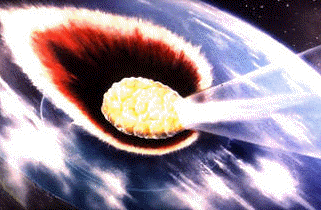
from a
National Museum of Natural History web page ]... it causes
a tremendous shock wave while transferring energy and momentum to
the ground. The impact was similar to a large explosion, although
the energy of the Chicxulub impact dwarfs anything modern
civilization has experienced. The energy of the impact was
comparable to 100 million megatons of TNT, 6 million times
more energetic than the 1980 Mount St. Helens volcanic eruption.
The impact ejected rock from several kilometers beneath the
surface of the Earth and carved out a bowl-shaped crater nearly
100 km in diameter. In addition, the shock of the impact
produced magnitude-10 earthquakes, which were greater than the
magnitude of any we have ever measured in modern times. ...[
According to a
Miami University of Ohio web page: "... In contrast to the 2
to 3 cm thick clay layer found worldwide, the K-T boundary in the
Gulf of Mexico region and in Haiti is composed of much thicker
very coarse clastic deposits. Sand beds indicative of high energy
deposition at the K-T boundary at Brazos River, Texas, have been
interpreted to be the result of a major disturbance of the
depositional environment, such as a tsunami approximately 50 to
100 meters high. ...". ]... The initial bowl-shaped crater
was very unstable, and its walls quickly collapsed along a series
of faults that enlarged the final diameter to between 145 and 180
km. At the same time, the rock that had been compressed
beneath the crater by the impact rebounded, producing a peak-ring
structure in the crater's center. These dramatic changes, which
rapidly transported huge volumes of rock over distances of tens of
kilometers, occurred within only a few minutes. ...
... Because the impact site was in a shallow sea,
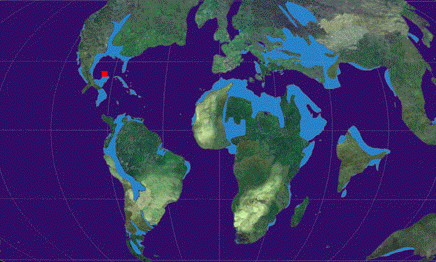
water rushed in to fill the circular depression. Kilometer high
waterfalls tumbled over the rim of the crater and roared furiously
across the floor of the crater.
Because seawater filled and covered the crater, sediment on the
bottom of the sea soon buried the impact scar. The crater is
no longer visible today, even when standing directly over it.
In more recent times, the impact crater has affected the
circulation of groundwater on the Yucatan Peninsula. This
groundwater, has in some areas, dissolved the limestone in the
Yucatan peninsula. Below ground, this has produced caves. At
the surface, this has produced cenotes which are groundwater
springs. The cenotes form a ring, like a blue pearl
necklace,
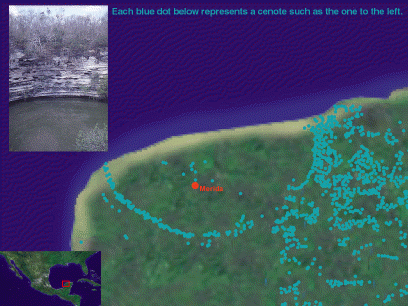
that is nearly coincident with the rim of the Chicxulub
structure and is the only visible feature on the surface to
indicate a huge crater lurks below. ...
... The explosion that produced the Chicxulub crater excavated
a huge amount of material, which was then ejected upwards. Most of
the debris was deposited as a blanket of material that covered
North America and possible South America. Near the impact
crater the debris is tens to hundreds of meters thick, while as
far away as Colorado (over 2000 km distance), the debris is still
a centimeter thick ... Additional material was lofted in an
expanding, vapor-rich plume that included gas from the vaporized
asteroid or comet. This plume rose far above the Earth's
atmosphere, enveloping it, and eventually depositing a thin layer
of debris around the entire world. ...".
According to a
Miami University of Ohio web page:
"... the hi res image of the Chicxulub impact crater
...[shows]... a groove leading into the crater which shows
the direction from which the asteroid or comet (rocky core type)
hit. The hi res image covers the Yucatán Peninsula. Note
the ejection plume pointing north and west out of the crater at
the southwestern United States. ...
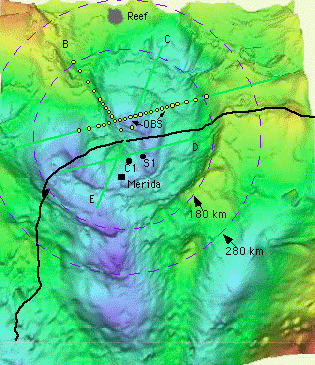
... The yellow arrow shows the hi res image of the Chicxulub
impact crater itself imposed on a larger, lower resolution image
of the Caribbean and Atlantic. ...
owes its doubly arced shape to the K-T impact shockwave.
...
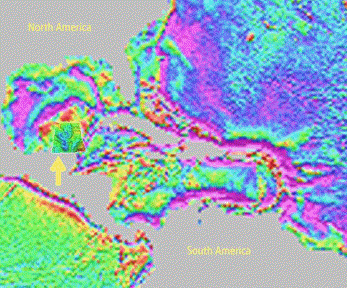
... there appears to be a gravitational anomaly (party dress
pink) arc ... on the floor of the Atlantic Ocean off Florida ...
which centers on the impact crater, as do several arcs in the Gulf
of México. In fact, features such as the Alacrán
Reef and Florida appear to be parts of the extended structure of
the complex crater. The Blake Nose drill sites for cores of the
K-T boundary are on the pink arc on the Atlantic side of Florida.
... This
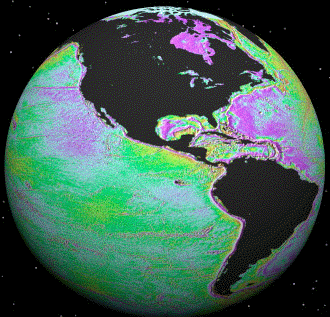
is a hi res rendering of the gravity anomaly satellite image
(Scripps Institute of Oceanography) that I mapped onto a sphere
(MetaCreations's Bryce 4). Some concentric arcs centered on the
Chicxulub crater are clear in the bright lavender tones of the
image. At high resolution on the images downloaded from the
Scripps Institution of Oceanography Geodesy site, there is
radial and concentric cracking of the Pacific Plate centered on
the impact site. ...".
Duncan Steel hypothesizes that the "...
giant impact in Mexico apparently induced seismic waves which were
focused on western India, causing fracturing which then led to the
widespread Deccan
eruptions. ...". Since India was then south of its present
position, the Deccan basalt traps of India were then roughly
antipodal to the Chicxlub Yucatan crater.
According to an
islandone.org web article released by Don Savage, and Diane Ainsworth
of JPL, dated 28 December 1994:
"... it was the sulfur-rich atmosphere created in the
aftermath of an immense asteroid collision with Earth 65 million
years ago that brought about a global freeze and the demise of the
dinosaurs. The impact of this large asteroid hit a
geologically unique, sulfur-rich region of the Yucatan Peninsula
in Mexico ... the impact kicked up billions of tons of
sulfur and other materials and was between 10,000 to 50,000
times more powerful than the comet
Shoemaker-Levy 9 impact on Jupiter last July. ... this
asteroid was between 10 to 20 kilometers (6 to 12 miles) in
diameter and its collision on Earth brought about total darkness
around the world for about half a year ... But more importantly,
persistent clouds generated by the impact on this geologically
distinct region of sulfur-rich materials caused temperatures to
plunge globally to near freezing. ... These environmental changes
lasted for a decade and subjected organisms all over the world to
long-term stresses to which they could not adapt in such a brief
time span ... Half of the species on Earth became extinct as a
result. ...
... it was the specific geological location of the impact in a
region that is rich in sulfur materials that created catastrophic
climate changes and led to the downfall of the dinosaurs. If
this asteroid had struck almost any other place on Earth, it
wouldn't have generated the tremendous amount of sulfur ...
On impact, the asteroid hurled some 35 billion to 770 billion tons
of sulfur high into the atmosphere, along with other
materials.
The NASA team ... recently discovered rocks in Belize -- some
the size of a small car -- that were blown out of the crater and
landed south of the Chicxulub site. The boulder deposit in Belize
also contained fragments of glass ... known as "tektites," ... The
tektites have been found in other regions near the crater, such as
Haiti, Mexico, Texas and Alabama, but never in association with
large boulders. Another important find at the Belize rock quarry
was limestone with fossils dating to the early part of the
Cretaceous. ... Early Cretaceous fossils have been found deep
below the surface near the crater during drilling by the Mexican
Petroleum Company. We think the limestone found in Belize was
excavated by the impact, which probably blew a hole more than 15
kilometers (nine miles) deep in the Yucatan Peninsula. ...
... The researchers used sophisticated atmospheric models of
the sulfur-rich atmosphere of Venus
to model their impact scenario. ... Initially, thick sulfur
clouds, combined with soot and dust generated by this impact,
would have spread worldwide and blocked out the Sun ...
Night-like conditions probably existed all over Earth for at least
six months essentially bringing photosynthesis to a halt.
Unlike the aftermath of typical impacts, the skies remained
murky for at least a decade, due to chemically generated clouds of
sulfuric acid high in the stratosphere. ... The reflection of
sunlight back into space from these high-altitude clouds caused
surface temperatures to drop to nearly freezing for many years all
over the planet. ... These atmospheric conditions occur in Venus'
perpetually cloudy atmosphere ... where ultraviolet sunlight and
water in the high atmosphere can convert sulfur dioxide into
sulfuric acid clouds. Sulfuric acid clouds like those that
cover Venus may
have continued to blanket the Earth for more than a decade after
the initial impact of the asteroid, causing a secondary and
more long-lasting effect which killed much of life on Earth.
...".
According to a
Fossil Cephalopods FAQ by Neale Monks:
"... Cephalopods ... evolved from primitive molluscs
during the Late Cambrian, approximately 500 million years ago.
Unlike the other molluscan groups, cephalopod evolution has
concentrated not on a energetically connservative, defensive
lifestyle but on mobility, dynamism, and intelligence. ...
... Cephalopods today are divided into the nautiluses, which
reproduces many times, and the coleoids which reproduce only once
(usually) ... The basic fact is that no ammonites are known beyond
the end of the Cretaceous, while the other cephalopod groups, the
coleoids and nautiloids, survive to the present day. This has been
tied with other extinctions which occurred at the end of the
Cretaceous (known as the Cretaceous-Tertiary, or
K/T, boundary). ... How the squids and octopuses, which lived
in the Mesozoic seas along with the ammonites, belemnites and
nautiloids, survived is unclear. ...".
Tony Smith's Home Page
......





